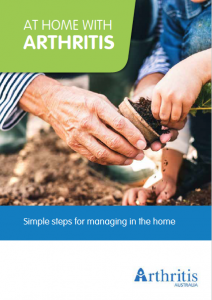Managing at home
When you have arthritis, joint pain and weakness can make normal activities around the home difficult. You might find some tasks cause pain or strain, and other activities become almost impossible. But don’t give up just yet! There are many ways that you can protect your joints from pain and strain and also make jobs around the home easier to manage.
Protecting your joints
Joints affected by arthritis are usually weaker and less stable than ‘normal’ joints. This makes them more vulnerable to damage, particularly from twisting or repetitive movements. As soon as you find out you have arthritis, it is important to start looking after your joints. Small changes in the way you do things can greatly reduce the stress on your joints and help prevent problems becoming worse in the future.
Here are some ways you can look after your joints:
Pace yourself
If you carefully plan and organise your activities you can make the most of your energy. Pacing helps you to finish what you want to do without increasing your pain.
Balance work and rest
When doing tasks around the house, set a steady pace and take a break BEFORE you get tired and sore. Alternate periods of rest and activity during the day. As a rough guide, try to take a 10-15 minute rest every one and a half hours. You can also rest different joints and muscles throughout the day by regularly changing activities. For example, switch from an activity that requires standing, to one that allows you to sit so that you can rest your legs and back. Remember, don’t overdo things on ‘good days’ as it could result in pain and fatigue the following days.
Respect pain
It is important to listen to your body and take notice of pain. Pain can serve as a warning. Pushing through pain can make it worse and can also increase stress, fatigue and joint damage. While pain messages should always be respected, a fear of pain can stop you from living an active life and can lead to further problems. Many people will give up on an activity if it hurts. However it is better to keep doing these activities a little at a time, with plenty of rests, rather than give up altogether something which you enjoy.
Work smarter, not harder
Look for ways that you can use tools or your environment to help you accomplish tasks. For example, slide objects along a bench rather than lifting them, take advantage of carts or trolleys when transporting large items.
Use the strongest and largest muscles and joints for the job
Use your strongest and largest joints and muscles to distribute weight and reduce joint stress and pain. For example, use your thigh muscles instead of your back to squat and lift an object.
Use joints in their most stable position
Muscles and tendons are at their strongest when the joints are in straight alignment. Try to avoid or change activities that put your affected joints into unstable or awkward positions. For example, when holding objects, try to keep your wrists straight and your fingers in line with your knuckles and wrist. Check the way you hold the kettle or iron, or how you carry a shopping bag.
Change the way an activity is done
Simply changing the way you do an activity can save time, energy and unnecessary joint pain. For example, can you do this task while sitting rather than standing? Sit at the table when chopping vegetables for dinner rather than standing if you have sore knees, hips or feet.
Avoid staying in one position for too long
Staying in the same position for long periods can lead to tired muscles and stiff joints. It is generally recommended to change positions or stretch every 20 minutes.
Use good body mechanics and posture
Always maintain good posture when sitting or standing. For example, when sitting, use a chair with a firm or supportive back rest. Try to avoid soft, ‘saggy’ couches.
Putting it into practice
 For practical tips and information on making daily tasks easier, check out our At home with arthritis: simple steps for managing in the home booklet
For practical tips and information on making daily tasks easier, check out our At home with arthritis: simple steps for managing in the home booklet
There are many products with useful features that can be purchased to help you protect your joints and make daily tasks easier.
If you would like to discuss arthritis and aids with our health educators, please call the Arthritis Infoline on 1800 011 041
Discover more...
-
Programs & Research
Arthritis Australia funds research and advocates to improve care, management, support and quality-of-life for people with arthritis.
-
10 steps for living well with arthritis
Here is our 10 steps checklist to help you live with arthritis.
-
Children and arthritis
Arthritis can happen at any age. Here, you can find management and treatment information specifically created for the more than 6,000 Australian children living with...
Sign up to Arthritis Insights
Regular updates, news and research findings delivered to your inbox: